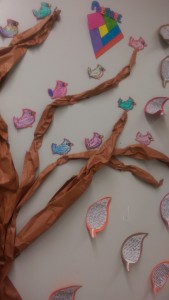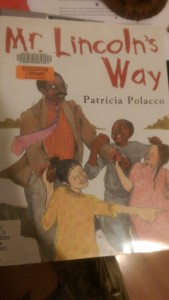Afterschool, I helped my school advisor coach volleyball. It was a fun experience and the kids all worked so well together. We talked about good sportsmanship and overall, just to have fun. It was fun to help mentor kids playing, since It’s been a long time for me. I got a chance to talk to other teachers and get familiar with extracurricular activities.
Monthly Archives: October 2014
SEL Continues…
My second part of my lesson plan was finishing reading Mr. Lincoln’s Way, and have a discussion regarding racism and bullying. The students were still actively engaged in the lesson and they were excited about the activity. The activity was having a cardinal bird with each of the students’ unique characteristics on it. Once they completed it, we put it on the back wall and we had a gallery walk. I wasn’t that nervous compared to my last lesson, I felt more confident. The only thing I felt that I needed to reassure myself was to come up with strategies for classroom management, and have a clarification on my activity.
My First Lesson!
Today in class, I taught my first lesson on social and emotional learning. I must say I was extremely nervous and excited at the same time. I taught my students about bullying and racism. I was surprised to see how many were keen listeners and actively engaged in my lesson. We talked about the different kinds of bullying behaviour and how it hurts other people’s feelings. Thus, we expanded our brainstorming by reading a book called, Mr. Lincoln’s Way by Patricia Polacco. This book is the perfect example of unfair treatment to all people and the kids really enjoyed it as well. After reading, it was time for a brain break, which prepared them to reflect on the readings and how it might make a connection to their life. Overall, my lesson was not bad at all, and there were areas that I would like to improve such as:
- Allowing time for students to think and respond.
- Allowing students to work with their neighbours about the questions.
- Explaining my activity clear, so students’ would have a better understanding of the criteria.
- Being firm with students that are not participating in the class activity.
I am going to work on these and hope to be better on my next lesson! Today was a good day 🙂
Reflection on Bumpy Moments
In the article, “Bumpy Moments” by Romano, really emphasized the reality of teaching. Teaching can be fun and enjoyable; especially when a teacher sees their student understanding the criteria and that they’re in a happy environment. However, at times, classroom management and the behavior of students can tend to be frustrating. Romano expressed how at times she was reaching her tolerance level when things were getting out of control. Romano expressed, “I was frustrated with the behavior of my students, a situation, or perhaps frustrated that there didn’t seem to be a solution in sight to resolve my problem” (Romano, 2004). I don’t think there is nothing wrong to express how a person feels, even if it is the job you love. I feel like there’re going to be times for myself to feel overwhelmed and that the situation isn’t going my way. Such as, getting the students attention or disagreements with the parents could be another issue. I would hope that my first year of teaching is a smooth transition, although having those “bumpy moments” can make me stronger and prevent situations from re-occurring.
Bumpy Moments
Self-Reflection is really important when managing a classroom. Reading the article on, “Bumpy Moments” by Romano, really opened my eyes of how to make quick decisions for any problems that may arise. My biggest fear is lacking confidents in classroom management. How will I have my students engage and respect me as their teacher? Romano addressed these in her article, and I felt that I wasn’t the only one that had these initial thoughts. I appreciated her telling her readers that classroom management and parents were her biggest ‘bumpy moments’ in her teaching career. She clarified by keeping journals or anything that will make her teaching more comprehensible will limit any awkward moments in the classroom. Learning is always looking back at experiences and reflecting on how to make things better if a situation occurs again. Teaching does require a lot of patience, but critically thinking of everything around the classroom and outside the classroom is also important.
Generating a Mini-Inquiry
September 30, 2014
Generating a mini-inquiry always begins small and continues to develop as your research grows. The questions I thought of as a teacher candidate is:
- How will my students understand my lessons I have planned for them?
- How will I find my teacher voice that will allow students to respect me as their teacher?
- How will I find a balance in the classroom?
- What are some effective techniques to make sure all students feel engaged?
All of these questions will continue to develop as I go through my practicum. I hope I will become a effective learner and an educator.
Exploring Teacher Inquiry
September 23, 2014
The article on “Reading, Riting, Rithmetic and Relationship: Considering the social side of education” by Shelly Hymel et al. help me to realize that
- Traditionally only focused on academic curriculum and had little impact on relationship roles. Hence, a good relationship with teachers and students and students with their peers help succeed in life as oppose to just having academics.
- I agree that children learn their social ties at school. Thus, teachers need to incorporate that into a child’s learning. They will understand the value of what is right or wrong, and behaving pro-socially.
- I gained a clear understanding that children may encounter a difficult time in school if they don’t address how to share and take turns; cope with problems; and be assertive when required.
- This article helped me what I should be looking for in the classroom and how to incorporate SEL into my teaching.
Understanding and Exploring Teacher Inquiry
September 16, 2014
The importance of teacher inquiry is to critically reflect at their teaching. It is a research method that builds strong connection of building a positive environment in the classroom. Thus, no perspective of inquiry should be denied and always scaffold and take ownership of one’s work. It is a learning experience that never ends. I feel that teacher inquiry is a critical step in becoming a profound teacher. I believe that if your passionate about something then you should never stop asking questions. It is the only way a person will improve their knowledge. I really enjoyed the Social and Emotional Learning (SEL) component into inquiry. How does SEL fit into Education? SEL fits into education of the ability to have self-awareness; self-management; social awareness; relationship skills; and responsible decision-making. These competencies help prepare students to know what society is like. Sometimes life is not fair and students need to have these skills to prepare for them. I feel it is the only way to have a safer environment for our future students.
Understanding Teaching as Inquiry
September 09, 2014
Article on “Reflecting Teaching: Professional Artistry Through Inquiry” by James G. Henderson discuses deliberative inquiry as an on-going learning process. It focuses on different points of view of how to solve problems. Thus, teachers are not only looking at one perspective, but many more. This article educated me to be a well- rounded educator. The problem I may encounter in my teaching career may constantly change, because learning new ways is evolving. Another important aspect I took close to heart is having a caring environment. A caring environment helps illuminate any fear in the deliberative process. More importantly, social and emotional learning is essential for a caring environment. Students will feel safe to communicate and have a positive atmosphere. They will feel self-regulated and have a social awareness in their classroom environment as well as outside of the classroom. Teachers will look at many possible solutions to reflect on inquiry and continue to ask more questions to solve solutions.


